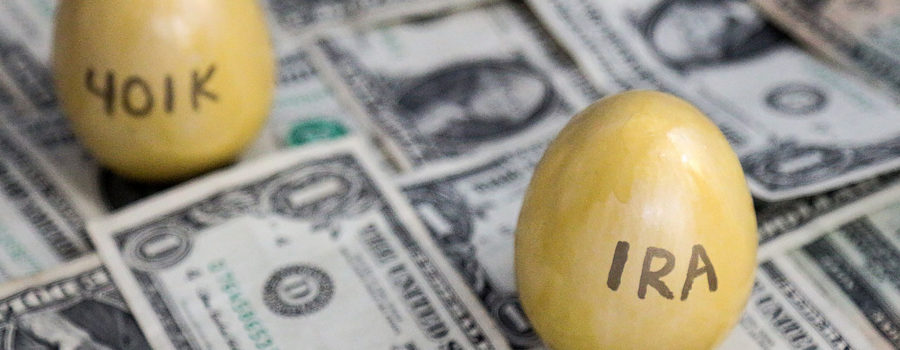If you’re like us, when we got our first job we started saving into the company retirement plan because that’s what we were told to do. Save for retirement and take advantage of the company match (if you were lucky enough to have one) was the mantra. When you’re working, the last thing you’re thinking about is taking money out of the retirement account. However, educating yourself early can have a huge impact on your financial success and how much you must pay to Uncle Sam.
Investors have many plans available to create a nest egg for their retirement days. The plans include 401(k)s, 457s, 403(b)s, SEP IRAs, SIMPLE IRAs, and Traditional and Roth IRAs. All these plans allow investors to reduce their taxable income by contributing and allows the assets to grow tax-deferred. The Roth IRA (or Roth 401k) contributions are made after-tax and distributions are not taxable during retirement.
What many people don’t think about as they are saving for retirement is the mandatory Required Minimum Distribution (RMD) rule that one is required to start taking when they reach age 70 ½. The one exception to the requirement rule is Roth IRAs. After years of saving diligently in retirement accounts, Uncle Sam needs to recover something for all the years of tax-deferred savings and investing they have allowed investors to accumulate. You must pay federal, and sometimes state, income taxes on the taxable amounts of these distributions. Failure to do so, may result in an IRS penalty tax of 50% of the amount not distributed.
So, when do I need to take the first RMD?
For IRAs, you must take your first RMD by April 1 of the year after the year you turn age 70 ½ – regardless of whether or not you are retired. For each following year, you must take an RMD by December 31. If you are working at age 70 ½ and have assets in an employer-sponsored retirement plan (401k, 403b, 457) at your current job, you may be able to delay taking distributions from that account until April 1 of the year after the year you retire.
The distributions can be taken in one lump-sum or spread throughout the year, as long as the RMD amount is distributed by the due date. These distributions are generally included in your taxable income and any distribution made through December 31 will be taxed in the current year. For this reason, many IRA holders choose to take their first distribution by December 31 of the year they turn age 70 ½.
Required beginning dates for RMDs from an employer plan (e.g. 401(k), 403(b), 457) vary depending on plan rules. You might not be required to take your first RMD until the later of April 1 of the year following the year you reach 70 ½ or the year you retire from work with that employer. Please note that you must take each RMD for a qualified employer-sponsored plan from that plan. You may not take the amount from an IRA.
Which accounts require distributions?
RMDs will need to be taken from Traditional, Rollover, SEP, and SIMPLE IRAs. Also, workplace savings accounts, including 401(k)s, 403(b)s, and 457 government-sponsored plans, are subject to RMDs. While Roth IRAs do not require RMDs, contributions to a Roth 401(k) plan do; however, if qualified, Roth plan contribution distributions are not included in taxable income.
If you are working at age 70 ½ and have assets in an employer-sponsored retirement plan at your current job, you may be able to delay taking distributions from that account until April 1 of the year after the year you retire.
Inherited IRAs are also a point of concern. While spouses are allowed to treat inherited retirement plans as their own and continue with the RMD schedule, non-spousal beneficiaries often don’t realize they have to take annual RMDs. Although the exact start date depends on a number of factors, the non-spousal beneficiary isn’t allowed to wait until he or she is 70 1/2 to start taking RMDs. As a result of this complicated distinction, non-spousal beneficiaries are urged to get solid advice in dealing with inherited retirement plans.
How do I calculate the RMD?
The amount of an RMD from an account is determined using IRS life expectancy tables and the prior year-end balance of the IRA. For IRAs and 403(b) plans, the account owner is responsible for calculating and taking RMDs. For qualified employer plans, the employer is responsible for determining the RMD amount and distributing the RMD.
If I have multiple IRAs, how many RMDs do I need to take?
If you have multiple IRAs, you must calculate the appropriate RMD for each one. However, the total distribution amount can be taken from one or more IRAs to satisfy the withdrawal – as long as the total RMD amount is withdrawn.
For example, if you have three different IRAs, you can take the whole RMD distribution from just one account. The 403(b) plan rules mirror IRA rules in that the total distribution from multiple 403(b) plans can be taken from one or more of the 403(b) accounts.
It’s different with 401(k)s. If you have multiple 401(k)s from prior jobs, each plan will calculate the RMD and send a distribution.
What if I don’t need to spend the distribution? What can I do with it?
Once the RMD is distributed, you don’t have to spend it if you don’t need to, but it cannot remain in the tax-deferred retirement account. Consider these ideas:
- Add it to your rainy-day fund or save for the longer term by reinvesting the money in a regular taxable account. Often you don’t have to sell securities out of the Traditional IRA to satisfy the RMD. Instead of liquidating some securities, you can have the assets transferred “in kind” to a taxable brokerage account. The account custodian will assign a fair market value as of the date of the distribution (that is, the transfer of assets from the IRA to the brokerage account) and issue a Form 1099-R showing the market value of the distribution for your tax return.
- Be charitable. If the fund holder doesn’t need the money for living expenses, he or she can contribute some or all of the RMD to charity. The IRS terms this a qualified charitable distribution (QCD) and up to $100,000 can be transferred to qualified charities. The contribution counts toward the annual RMD and amount is not included as taxable income. Doing this can possibly lower a holder’s income tax bracket and cut the tax paid on Social Security benefits.
- Invest in someone’s educational future by using the funds to contribute to a 529 college savings plan or adding to one that’s already been established.
What can I do before 70 ½?
For many individuals, the amount of the RMD may be larger than what is needed for living expenses therefore income tax is being generated on funds that aren’t needed. In these situations, a Roth conversion is one way to reduce the amount of the RMD by shifting assets from the IRA to a Roth IRA prior to age 70 ½.
The perfect time to evaluate whether a Roth conversion would be beneficial is the time when one retires (ideally before age 70) and before they turn 70. During this period, it is assumed they are no longer earning income and therefore may be in a relatively low or lower tax bracket than they would be once they begin taking their RMD. Converting assets from an IRA at this time could potentially be done with minimal tax liability and when age 70 ½ does arrive, the balance of the IRA has been reduced. This advance tax planning strategy is especially helpful for those where the actual required distribution moves them into a higher tax bracket thereby paying more tax than necessary. And if you recall, Roth IRAs do not have a required minimum distribution and the money grows tax-free.
Like all laws and regulations that deal with money and income taxes, there are a lot of different paths and variations to follow depending on the vehicle one is using. Not only should one try to be proactive and consult expert advisors to learn how to limit the size of RMDs and keep taxes down, he or she also needs to determine how to avoid the 50% penalty that is imposed if one violates the rules.




